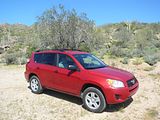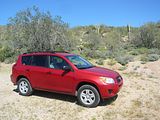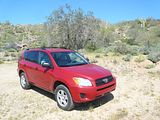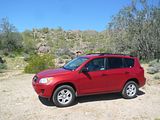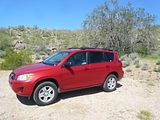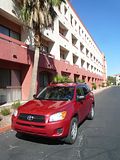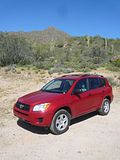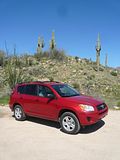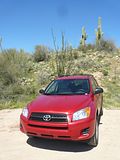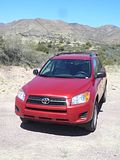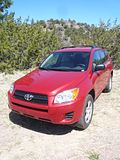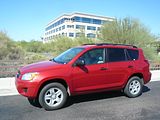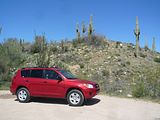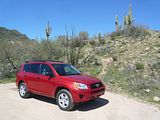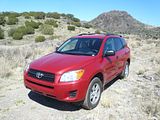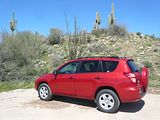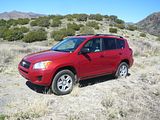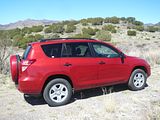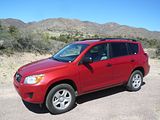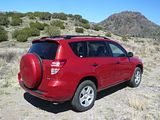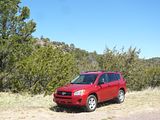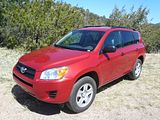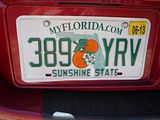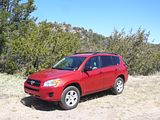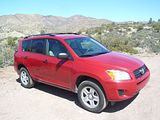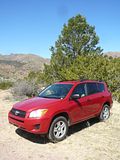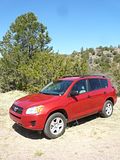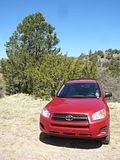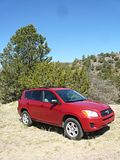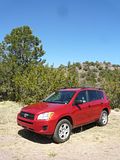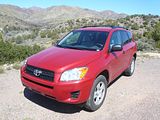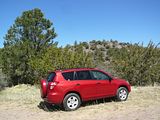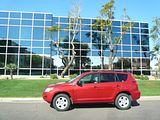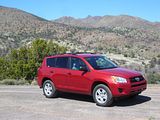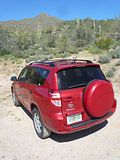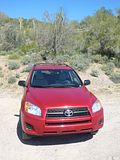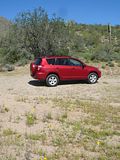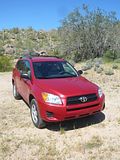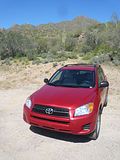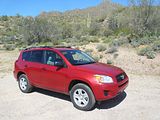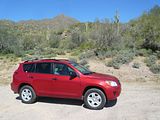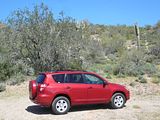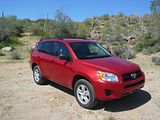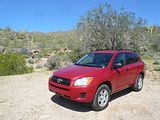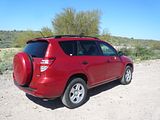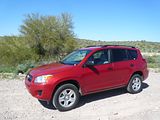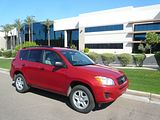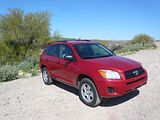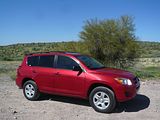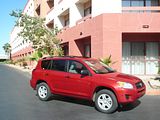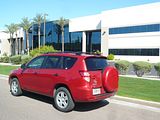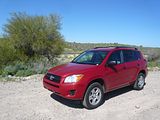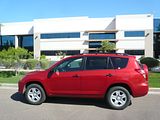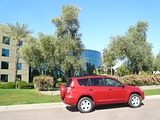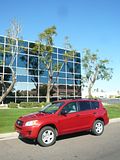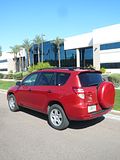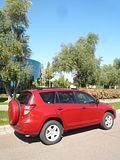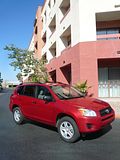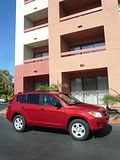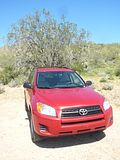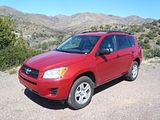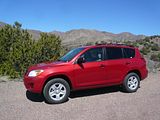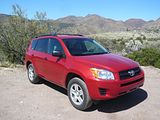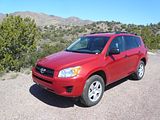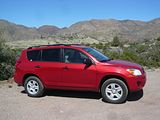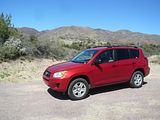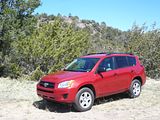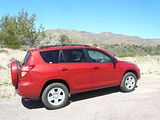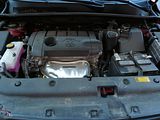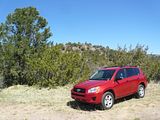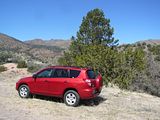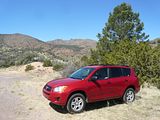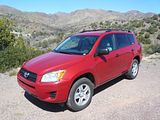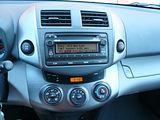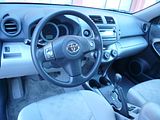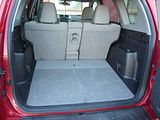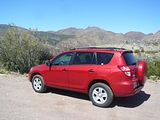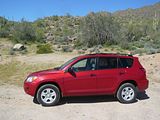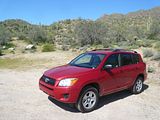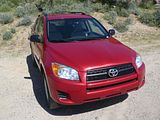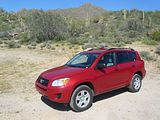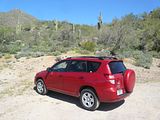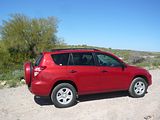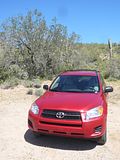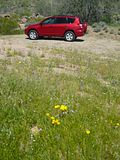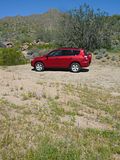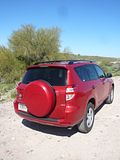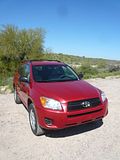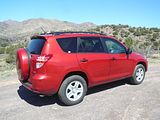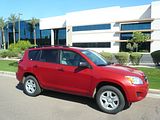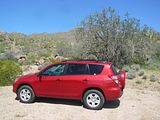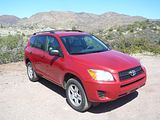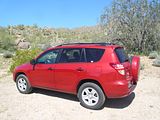In 1994, when Toyota presented the first RAV4, the automotive landscape looked quite different to the one we encounter in 2013. Mind you, you could argue that that first RAV4 was also a different sort of car. The production version of a concept car, this small three door machine was aimed at those who wanted a fun vehicle and either had got bored with the “hot hatch” or who had fallen foul of the massive increase in insurance premiums that had been seen in the previous couple of years. Memorably, Autocar magazine even ran a serious comparison of Toyota’s then new and rather pert offering against the Ford Escort RS2000 of the day. It did not take long, though, before a long wheelbase version of the RAV4 was presented and effectively Toyota had the world’s first compact-sized SUV. As is the way with these things, the second generation model, launched in 2000, took the same concept as the first but focused in a different way, so whilst there was a three door model, it was the five door that seemed commercially more significant, and by the time of the launch of the third generation model in 2005, the RAV4 had become a five door only model. It had grown noticeably too, as by this time, a whole plethora of rivals had sprung up, and Toyota needed to compete where volume sales were up for grabs. Nowhere has embraced the SUV as enthusiastically as America, so it was not a surprise to discover that US market third generation RAV4s would differ from those sold in Europe and Asia, principally in that they would be longer, as well as coming with different and larger engines. The extended wheelbase version was subsequently offered for sale in Japan, as the Vanguard. Ignoring the hiccough in sales in 2010 caused by the floor mat saga that hit Toyota hard for a while, the RAV4 has sold very strongly, with only the Camry and Corolla achieving more annual sales for Toyota in America and it has always scored very well in comparison tests published by the US press. I sampled a Swiss spec RAV4 back in 2009, and was not so favourably impressed, finding it a rather bland machine which although lacking serious fault also lacked any really compelling reason why you would want one over its competitors, so on the eve of sales of an all-new and even larger fourth generation model, thought it time to grab the keys to an American market model to see how it fares in the continent that bought over 171,000 of them last year.
When you dig a little deeper, it would seem that one of the main reasons that the American press like the RAV4 is because it is available with a class-leading potent 269 bhp 3.3 litre V6 engine, which apparently endows it with quite lively performance. Needless to say, rental spec models don’t have this powerplant as they come with the big-selling 2.5 litre 4 cylinder unit instead, an engine that also sees service in the Camry. The test car did sport the optional four wheel drive, though, readily identified by a badge on the back and a diff lock control on the dashboard. Developing 178bhp, this is no ball of fire, but nor is it embarrassingly slow. In fact, it gives you the first clue to the RAV4, if the fact that it is a Toyota does not get you there already, in that it is perfectly fit for purpose, no more and no less. It is decently refined until you work it hard, and once you reach steeper inclines you probably will need to do so, especially if the RAV4 were fully laden, but one up and in the cut and thrust of ordinary traffic it is fine. Toyota must be one of the last to persist with the sort of automatic gearbox that everyone else moved away from years ago. There is a simple PRNDL set of markings alongside the lever, with no choice of Sport mode and no manual shifting possible. The 4 (yes, 4!) speed transmission is smooth enough, but it did feel like a relic of a now bygone era. Because of the deal I had with Hertz, I did not need to buy fuel for the RAV4, so the only clue I have to fuel consumption is that recorded by the on board trip computer, which advised that during my tenure I achieved 25.4 mpg (30.3 mpg Imperial), which I thought was not that impressive compared to other recent test vehicles and noting that I did not subject the Toyota to any urban crawl and it did get the benefit of plenty of steady speed running. Where I did get a surprise, and a pleasant one at that, is with the steering feel. This is a Toyota and yet it actually had some. Yippee! It must be the first example of the marque that I’ve driven for ages where the steering is not so ridiculously light and vague that you are convinced that if it is not telepathy connecting the steering wheel to the road wheels then it is probably cooked spaghetti. Don’t rejoice too much, as I would not say that the steering feel is very good, but at least there was some way of getting feedback on where the steered wheels were going to point. With any aspirations at conquering the one time hot hatch buyer gone, then handling prowess is clearly not high on the “must achieve” list for the engineers and the RAV4 whilst feeling perfectly safe is not a car that you would ever take on a winding road, “because it is fun”. It understeers a bit, but unless you do something stupid, you should not get into trouble with it, either. You might just get there with the brakes, though, which although fine in gentle use, seemed to require quite a hard push of the pedal when travelling more quickly to come to the requisite halt. A conventional pull-up handbrake lever sits between the seats. No such problems with the ride, with the Toyota coping well with the smooth surfaced roads of Arizona. And nor is visibility an issue. There is plenty of glass, the mirrors are of a good size and with the top part of the spare wheel evident in the rear window, you know that you have the depth of that behind you when reversing.
Open the door, look inside and what do you see? Grey. Lots and lots of grey. Admittedly in several different shades, though thankfully not as many as 50 feature. The seats are in a sort of grey velour type material, with a light pattern on the central parts, and the dash and door casings are a mixture of the same grey, with a much darker, almost black colour on the top surface, and a dark grey inlay around the audio unit in the centre of the dash. The door casings comprise the same combination of hues. The dashboard is essentially the same as that in the European spec cars, as I found out when I refreshed my memory and looked at the pictures of that Swiss test car, though there are differences around the installed audio unit. The instruments look like three slightly overlapping circles, with the central one, containing the speedometer slightly larger than the outer pair which contain rev counter and ancilliary gauges. They are clearly presented and easy to read, though. The rather basic audio unit sits high in the centre of the dash, astride a pair of air vents, on what looks like a vertically mounted plinth. This is because the lower part of the dash has an unusual curvature to it, which I guess was a stylist’s attempt to add something slightly out of the ordinary to the appearance. The lower section contains three rotary knobs for the air conditioning and a small and rather awkward to see digital display for the clock. Twin column stalks operate indicators, wipers and lights. There are only a couple of buttons on the steering wheel boss, for radio volume and channel, and there is a separate column stub for the cruise control. Unusually, the switches for adjusting the door mirrors on the centre console, and they point forwards so you do not instantly see them when you first get in and want to adjust things. Apart from this, everything else is all very intuitive to use, and feels solid enough, but lacks any visual flair at all.
RAV4 is what the Americans call a “Compact” SUV but don’t let that fool you into thinking it is small and pokey inside, as it is not. Thanks to the longer length of US market cars, there is an option for two additional seats in the rear of the Toyota, though I don’t think anyone bigger than a midget would want to ride far on them. They were not fitted to the test car, which had a couple of underfloor stowage areas in their place. But even as a five seater, this is a decently roomy vehicle. That said, the centre of the rear seat of this model was similar to that in the larger Highlander I sampled a few days earlier, in that it comprises a fold down armrest which has an array of cup holders on its upper surface. When this element is clipped in place against the seat backrest, it looks like it would be far less comfortable than the rest of the seat. The asymmetrically split seats are on sliders, and the angle of the backrest can be adjusted from very upright indeed to modestly reclined. Even with the seats set forward, there is decent leg room and headroom is not lacking. Thanks to that extra length, and the fact that the spare wheel is mounted on the rear door, there is a good sized boot even when the rear seats are in use, but if you fold them down, there is a lot of luggage space indeed. One very distinctive feature of the RAV4 is that rather than a conventional tailgate there is a side hinged rear door. This can prove a real challenge, as to open it you need far more clearance from any obstacle (another parked car, for instance) behind you, and whilst the door is easy to open, and not heavy despite having the spare wheel mounted on it, is clearly a feature that even Toyota noted no-one copied and have abandoned on the fourth generation model. Inside the cabin, there is a split level glove box, though the top half is not very big, and there are pokey door bins for front seat passengers. Rear seat occupants get just a bottle holder on the doors, and have to content themselves with map pockets on the back of the front seats. There is also a deep cubby on the dash under the air conditioning controls and a split level cubby under the central armrest.
As well as the choice of 4 or 6 cylinder engine, and front or all-wheel drive, Toyota offered the RAV4 to its American customers in three distinct trim levels: base, GS and SE. The test car was a basic one, and basic is really the operative word, as there were no luxuries or fripperies at all in evidence. All US market RAV4s had an automatic gearbox – the antiquated 4 speed for 4 cylinder models and a 5 speed on the V6s, and the test car featured cruise control, air conditioning, a rather old tech looking AM/FM/CD/MP3 audio unit, roof rails and that is about it. Higher spec models offer dual zone automated climate control, leather seats, a back-up camera, power sunroof, navigation system and an upgraded audio unit including satellite radio.
The American press and people may have taken to this RAV4 in a big way, but I’m afraid I did not. There is not really anything wrong with it, but nor is there anything that stands out. I am sure it would prove a reliable vehicle to own over many years, and as it is decently practical, that is all that many people want, but if this is all about Recreation and Activity, as in the name of the thing, then I think that buyers have a right to expect a little more. Especially when vehicles such as the Mazda CX5 and latest Ford Escape deliver it. They are just as practical, but by all accounts they are also good to drive. Comparing those new designs with the 7 year old RAV4 may be a little unfair, but nothing I’ve read suggests that the all new 2013 RAV4 will be anything more than a competent appliance just like its predecessor. With global sales of 428.414 RAV4s last year, though, it is clear that there are an awful lot of people who like automotive appliances with a small SUV packaging.


